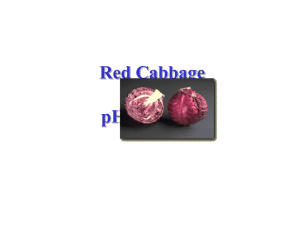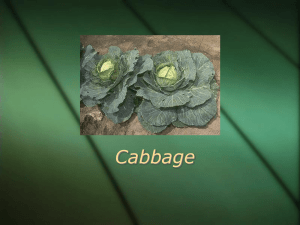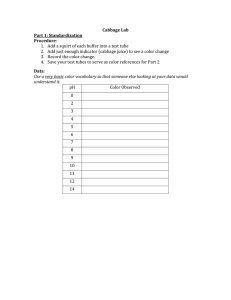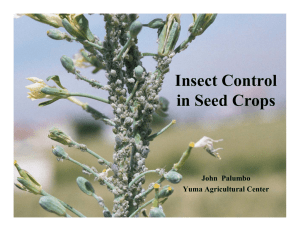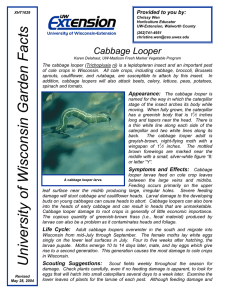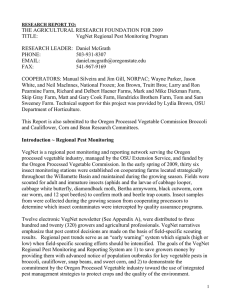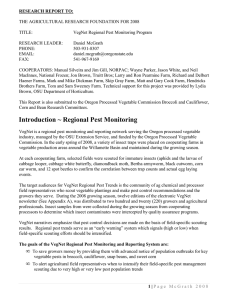COOPERATIVE EXTENSION NEWSLETTER
advertisement
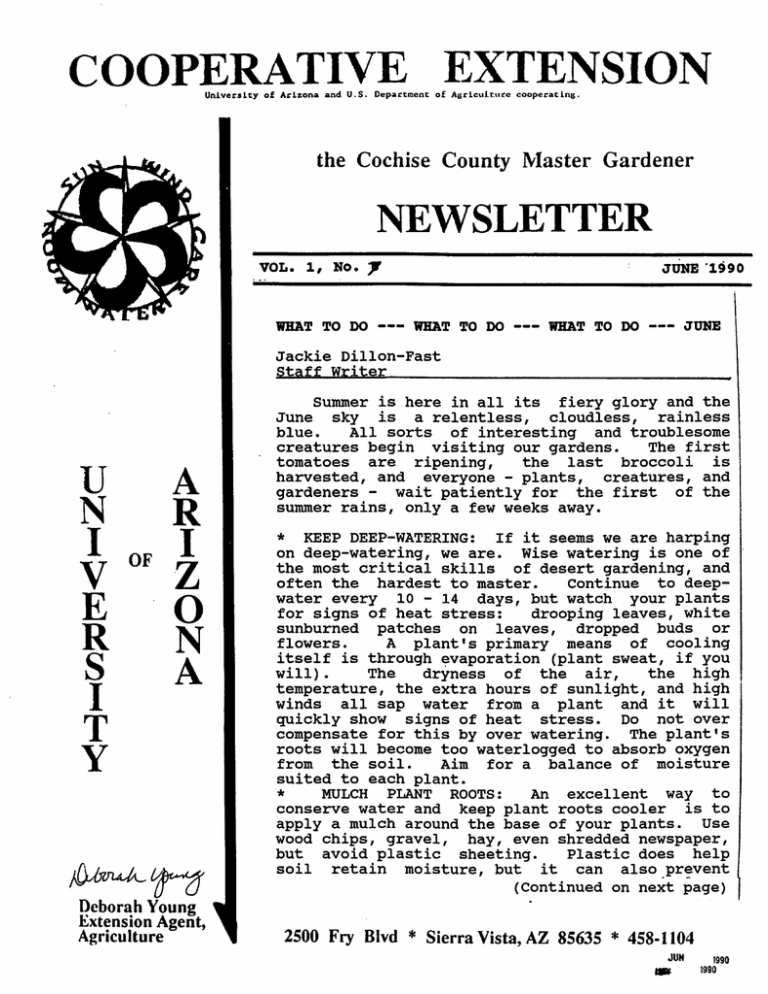
COOPERATIVE EXTENSION University of Arizona and U.S. Department of Agricuittice cooperating. i the Cochise County Master Gardener kM. NEWSLETTER VOL. ly No. y JUNE 1990 WHAT TO DO WHAT TO DO WHAT TO DO JUNE Jackie Dillon-Fast Staff Writer Summer is here in all its fiery glory and the sky is a relentless, cloudless, rainless blue. All sorts of interesting and troublesome creatures begin visiting our gardens. The first tomatoes are ripening, the last broccoli is harvested, and everyone - plants, creatures, and gardeners wait patiently for the first of the summer rains, only a few weeks away. June u N I V E R S I T Y OF A R I Z O N A * KEEP DEEP-WATERING: If i t seems we are harping on deep-watering, we are. Wise watering is one of the most critical skills of desert gardening, and often the hardest to master. Continue to deepwater every 10 - 14 days, but watch your plants for signs of heat stress: sunburned patches on drooping leaves, white leaves, dropped buds or flowers. A plant's primary means of cooling itself is through evaporation (plant sweat, if you will) . The dryness of the air, the high temperature, the extra hours of sunlight, and high winds all sap water from a plant and it will quickly show signs of heat stress. Do not over compensate for this by over watering. The plant's roots will become too waterlogged to absorb oxygen from the soil. Aim for a balance of moisture suited to each plant. * MULCH PLANT conserve water and ROOTS: An excellent way keep plant roots cooler to is to apply a mulch around the base of your plants. Use wood chips, gravel, hay, even shredded newspaper, but avoid plastic sheeting. Plastic does help soil retain moisture, but i t can also prevent (Continued on next page) Deborah Young Extension Agent, Agriculture 2500 Fiy Blvd * Sierra Vista, AZ 85635 * 458-1104 JUN 1990 1990 moisture from plant's reaching roots tion. during There are a your irriga handful of plastic mulches on the market that permit water to penetrate, but block weed growth. You may want see to try these to they work well (then, know). In general, if let us mulches reduce weed growth by blocking out the sunlight needed by some seeds for germination. * FERTILIZE ROSES: By now your roses have feasted happily on the fertilizer you applied in April and are hungry again. Give them and other plants in your garden an extra boost this month with a side dressing of ammonium sulfate, ammonium phosphate, fish emulsion, blood meal, or any of the other nitrogen-phosphorous fertili zers. Watch plants for signs of iron or zinc deficiency problem in our soil. * COOL COOL-SEASON CROPS: - a If you*re planning on extending your cool-season crops into June, you*11 need to give them extra protection. Use shadecloth to shield mid-day sun them from and mist them the with Cabbage loopers and tomato hornworms (ickl) will be parti cularly troublesome. The best control for caterpillars is handpicking, but this must be done daily and is not for the squeamish. Check out this month *s **What*s Bugging You** for the inside scoop on cabbage loopers. * GIVE YOUR TOMATO PLANTS SOME EXTRA TLC: Stake tomato plants that need extra support as soon as possible. they are too Don*t wait until big and sprawling, and hopefully weighted down with tomatoes, to stake easily. Don*t be concerned if your tomato blossoms are dropping or if fruit production has stop ped. Temperatures may be too high for the pollen to remain viable. Be patient. Your plants will be fruiting again in another month. If you already have green tomatoes, be certain to keep a steady moisture level in their soil (damp, not soggy). Although there is still some debate, moisture stress i s considered the ing cause of blossom lead end rot in tomatoes. water daily to lower the sur face temperature of their leaves. You may also want to shade heat sensitive perennials if they begin to show signs of stress. * PLANT WARM-SEASON CROPS: You can continue planting warmseason crops such as melons and peppers. You will want to plant warm-season crops so that they will mature before the first frost, but that is five months away. * WATCH FOR NEW PESTS: Cat erpillars of all sizes and colors (some quite beautiful) will be happily munching on your garden this month. Those beautiful black swallowtails, stunning sphinx moths, little white and cute butterflies enlivened your spring were busy garden laying that this eggs. Editor: Thomas Christian Illustrator: Rose V. Land Staff: Jackie Dillon-Fast Carolyn Gruenhagen Merrianne Lange T. J. Articles Martin to be published next month *s newsletter received at the Extension Office June in must be Sierra no later Vista than 22. .iUN <990 BYE DEBORAH! HOW DO YOU XERISCAPE? As the newsletter goes to press, we bid a fond farewell to our Extension Agent, Agriculture, Dr. Deborah Young. Deborah has accepted a position in Yavapai County as Extension Agent, Agriculture and County There are seven basic Director. From a l l the Gardeners, Deborah, Master "We will landscape principles for xeriscaping; 1. Start with a plan. Put higher water use plants close to the house for greater energy savings. Group plants, shrubs, and trees together according to t h e i r water needs. miss you!" 2. Limit turf areas. only in areas where Put grass it provides functional or recreational bene fits. YOUR CHANCE TO INFLUENCE THE FUTURE OF RECYCLING! Consider systems drip ir for trees, shrubs, and groundcovers. staff Writer You have only a few more days the Install an efficient irriga rigation Jackie Dillon-Fast to influence 3. tion system. future of two major recycling bills before the 4. Harvest rain water roofs for beneficial use. 5. Improve the soil. Decom federal legislature. posed plant On June 13th, the Senate Com merce Committee will hold a water absorption. Cover the soil. Inorganic groundcovers minimize evaporation and reduce weed growth (weeds use water hearing on the National clable Commodities and the National Commodities (S1885). the Recy Act (S1884) Recyclable Financing The acts Federal Act require that Government recycled products use whenever pos sible, and conduct a national campaign encouraging the private sector to do will also establish the same. They a national clearing house to collect and distribute recycling informa tion. The save bills are designed provide improve too). 6. Use low water plants. There's one for virtually every landscape function. Visit your local retail nursery for assist ance. 7. Remember appropriate mainte nance. Careful pruning, ing, and watering weed will increase your water savings. to us taxpayers money, re sources, landfill space, and make recycling easier organic mulches nutrition and from for indi VIDEOS AVAILABLE vidual citizens. Are you for or against these bills? Let your legislators know by writing the Senate Com merce Committee, Washington, D. C. 13, 1990. U.S. Senate, 20510 by June Propagation of Plants Part I and JJ, Budding: New Life For Old/Fruit and Nut Trees videos are now available at the Sierra Vista Extension Office use. Stop by for your and check them out! JUN 1990 CUTTINGS * IN* GLOBAL RELEAP BEGINS CLIPPINGS There * s a new library available in resource the Sierra Vista office! Home gardening bulletins from Cooperative Extension offices U.S. are and ready all over catalogued for by use. the title A very simple check-out procedure is posted on the front of the file drawer containing the Use i t and enjoy them! * The library. apparently grew little feet and scampered away! Should you encounter any of these escaped articles, please return them to the Sierra Vista Insect Global ReLeaf part Control which is in of a turn worldwide Through volunteer efforts and government and private funding, Arizona Global ReLeaf hopes to plant and maintain 3.5 million drought tolerant trees in Arizona by the year 2000. These office. 1. Cochise County volunteers met recently in Bisbee to organize a county-wide tree planting program. The program is in cooperation with Arizona environmental effort. following home gardening bulletins Jackie Dillon-Fast Staff Writer Guide for Organic Gardeners 2. Hobby Greenhouses 3. When to Harvest Vegetables 4. Integrated Pest Management 5. Organic Gardening and Pest up of trees will carbon reduce dioxide environment build in and the the associated global warming, conserve energy by lowering cooling needs, and beautify the state. Control Each county and a city in * Reminder: The Sierra Vista Extension Office hours continue to be 9:00 am Noon, Monday - Arizona which forms Friday. will be eligible for state and federal support. The primary focus of each organization will be growing and planting drought organization to local ReLeaf Global volunteer coordinate efforts tolerant trees in c i t i e s and on public to encourage and a s s i s t homeowners with tree land, and planting on their own property. r The Cochise County Global ReLeaf organization needs more volunteers to help set goals, grow trees, provide information, design programs, and plant trees throughout the county. The success of the program depends on you. You can contact Cathy Wertz, County Coordinator, at 354-5477 for more information or to offer your help. JIIN mo WHftT'S BygQINg YQV? by T. J. Martin CABBAGE LOOPBRS COMMON NAME: Cabbage looper or inchworm. SCIENTIFIC NAME: DESCRIPTION: forewings. IN YOUR GARDEN Trichopluaia ni Adults - Small, mottled-brown moths with a silvery spot on the The wing-span is about 1 1/2 inches and they fly at night. Pupae - A green or brown pupae can be found wrapped in a white silken cocoon attached to a plant leaf. Larvae - A large (up to 1 1/2 inch) light green caterpillar with a light green stripe down its back. It gets the name "inchworm" from its looping-type movement from place to place. EcQS - The round, greenish-white eggs are laid singly, usually on the upper surface of leaves. LIFE CYCLE: The cabbage looper overwinters in the pupal stage in leaf litter. In the spring, the adult emerges and lays eggs on a host plant. In a few days the small green caterpillar hatches and starts to feed voraciously. When it reaches full size, the larvae then spins a silk-like cocoon and attaches pupates. In itself to the underside of a leaf, about two weeks the new adult will emerge and fly away seeking to mate and lay its eggs. This cycle will repeat itself approximately every three weeks throughout the summer. In the fall, the last generation will overwinter as pupae. HOST PLANTS: Beans, broccoli, brussels sprouts, cabbage, cauliflower, celery, collards, kale, kohlrabi, lettuce, parsley, peas, potatoes, radish, rutaibagas, spinach, tomatoes, and turnips. TIME OF THE YE2^: From spring (late April or early May) until late fall. WHAT TO LOOK FOR: The first sign of cabbage loopers is usually holes eaten in the leaves of your plants. It may be small holes, but you will most likely see large, ragged pieces missing or even entire leaves gone. You may find small brown pellets or droppings on what remains of the foliage. Closely inspect the leaves for eggs, pupae, or larvae of the pest. PROBLEMS AND DAMAGE: Plants can be virtually defoliated in a very short period of time. This not only destroys plant parts you may have been planning to eat, but if enough is eaten, the whole plant will die. Even if the plant survives, it will be weakened and more susceptible to other pests and diseases. CULTURAL CONTROLS: Practice crop rotation (3-5 year cycles) and plant resistant varieties when available. Clean up garden debris to destroy overwintering hedsitat. Use "timed planting" and plan your crop so that your most vulnerable plants (young, with few leaves) are not exposed to the pest. Start your plants inside so that you can transplant large seedlings outside. If damage is noted, remove the leaf or carefully cut away the chewed area. This way, if you notice more holes later, you will know that you still have the pest present rather than thinking that it is still the same damage from before. COMPANION PLANTING AND REPELLENTS: Marigolds, garlic, onions, sage, hyssop, rosemary, tansy, hot peppers, and thyme have all been used to keep the loopers .MO at bay. You can also make a spray from them (alone or in combination), with onions, garlic, and hot pepper solutions reported as working the best. TRAP PLANTS; Plantings of amaranth or celery close by can sometimes give you warning that the loopers are in the area as the pest often attacks them first. MECHANICAL CONTROLS: The best defense agricultural fleece product (Remay, eggs then there will not be any may etc.). be If caterpillars to cover your crop with an the moth can't land to lay her eating your plants. Be very careful to secure the edges and leave enough extra cloth for the plants to grow. You may have to remove the cover later if it gets too hot under there. Spraying your plants with a hard stream of water or soapy water may dislodge the pests so you can pick them up and destroy them. Hand picking and squashing them is very effective. Diatomaceous Earth (DE) or salt sprinkled on the creatures will dry them up. Use "bug lights" or light traps to get the adults. NATURAL CONTROLS: Cabbage loopers and other caterpillars are a favorite meal for lacewings, ladybugs, lizards, toads, and all sorts of birds. Trichogramma wasps parasitize their eggs and destroy them. If you find any loopers that appear chalky white and almost dead, collect them and make "bug juice" out of them. They have a disease called Nuclear Polyhedrosis Virus (NPV). A single spraying of this virus may be enough to control your cabbage looper population for the entire season1 Unfortunately, it is not yet available commercially. Bacillus thuringiensis (BT) is a commercially available bacterium that will kill caterpillars and is harmless to other creatures. Start the first damage and every two weeks thereafter. You spraying when you see can even use it as a preventive and start spraying about one week after transplanting if you have had problems with this pest in the past. BIOLOGICAL INSECTICIDES: These are not totally harmless, but used correctly, they can be easier on the environment than some other methods. Use an insecticidal soap (such as Safers), pyrethrum, ryania, sabadilla, or rotenone. Spray in the evening when the honey bees are not around, and follow directions carefully. CHEMICAL CONTROLS: Call you County Extension Agent or the staff for current recommendations. Check at your favorite garden supply store or nursery to see what they have available. Remember to check the label to make sure that the cabbage looper is a listed target pest and FOLLOW THE DIRECTIONS EXACTLY1 When it comes to pesticides, more is NOT better 11 Wear protective clothing, watch out for non-target plants, pets, children, and other living things. Wash your skin and clothing after application, and take care not to get the substance into your eyes, mouth, or breathing passages. m. Cabbage looperlarva Adult m 1930

